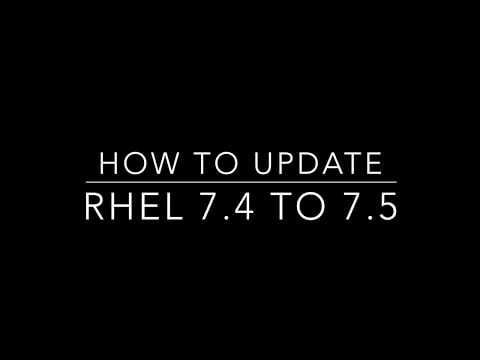Red Hat Enterprise Linux (RHEL) 7.5 がリリースされました。 このバージョンには、GNOME のバージョン 3.26 へのリベース、LibreOffice のバージョン 5.3 へのリベース、libva (VA-API) のサポートの追加、GStreamer の mp3 サポートなどの更新とさまざまな改善が含まれています。 RHEL は、ベアメタルとクラウド プラットフォームの両方に対応する主要なエンタープライズ Linux ディストリビューションの 1 つです。 商用ユーザーを対象としています。 RHEL は、x86-64、IBM System z、およびその他のプラットフォームで動作します。
RHEL 7.5 リリース以降ノート:
オープンソース ソリューションの世界有数のプロバイダーである同社は本日、世界をリードするエンタープライズ Linux プラットフォームの最新バージョンである Red Hat Enterprise Linux 7.5 の一般提供を発表しました。 Red Hat Enterprise Linux 7.5 は、ハイブリッド クラウド環境の一貫した基盤として機能し、強化されたセキュリティとコンプライアンスの制御、ストレージ コストを削減するツール、および使いやすさの向上を提供するだけでなく、オンプレミスと Microsoft Azure の両方で Microsoft Windows インフラストラクチャとのさらなる統合を提供します。
RHEL7.5がリリースされました
RHEL 7.5 リリースのいくつかの新機能:
- 起動時に Network Bound Disk Encrypted (NBDE) デバイスのロックを安全に解除
- Red Hat Ansible Automation と OpenSCAP の統合により、自動化が容易になります
- インライン重複排除とプライマリ ストレージの圧縮を通じてデータの冗長性を削減するように設計された Virtual Data Optimizer (VDO) の導入
- KVM 仮想化が IBM POWER8/POWER9 システムでサポートされるようになりました
RHEL 7.5 のパッケージを更新する
- Linux カーネル バージョン 3.10.0-862
- kernel-alt パッケージには、カーネル バージョン 4.14 が含まれています。 このカーネル バージョンは、64 ビット ARM、IBM POWER9 (リトル エンディアン)、および IBM z Systems をサポートします。
- LVM v2.02.177-4
- qemu-kvm v1.5.3-156
- サンバ v4.7.1
- ディレクトリサーバー v1.3.7.5
- binutils v2.27
- ヴァルグリンド v3.13.0
- rsync v3.1.2
- ノーム v3.26
- リブレオフィス v5.3
- GIMP v2.8.22
- インクスケープ 0.92.2
- qt5 5.9.2
- もっとここに
RHEL 7.4 から 7.5 にアップデートする方法
RHEL をバージョン 7.4 から 7.5 にアップグレードまたは更新する手順は次のとおりです。
- root ユーザーとしてログインします
- yum check-update コマンドを使用して更新を確認する
- yum update コマンドを使用してシステムを更新します。
- reboot コマンドを使用してサーバー/ボックスを再起動します。
- 新しいカーネルとアップデートを確認する
すべてのステップを詳しく見てみましょう。
ステップ1 -現在のカーネルのバージョンをメモします。
次の uname コマンドを入力するか、猫コマンド へ RHEL カーネルのバージョンと OS 情報を表示する:$ uname -a
$ uname -r
$ cat /etc/os-release
ステップ 2 – バックアップ
バックアップを作成します – バックアップを作成する前にシステムのバックアップを作成することがどれほど重要であるかは、どれだけ強調してもしすぎることはありません。 この投稿にリストされているアクションのほとんどは、bash またはその他の最新のシェルを実行している root ユーザーによって実行されることを想定して書かれています。
ステップ 3 – アップデートを確認する
次のように入力しますyumコマンド:$ sudo yum check-update
ステップ 4 – アップデートを適用/インストールする
次のように入力しますyumコマンド:$ sudo yum update -y
ステップ 4 – RHEL 7.4 ボックスを再起動します。
次のように入力します再起動コマンドまたはシャットダウンコマンド:$ sudo reboot
OR$ sudo shutdown -r now
ステップ 3 – RHEL 7.5 アップデートを確認する
次のコマンドを入力します。$ uname -a
$ uname -r
$ cat /etc/os-release
$ tail -f /var/log/logfilenames
$ dmesg | grep -i 'err|warn|cri'
$ ss -tulpn
バージョン 7.5 のサンプル セッション:
ビデオデモ
アップグレード手順を示す簡単なビデオデモは次のとおりです。

